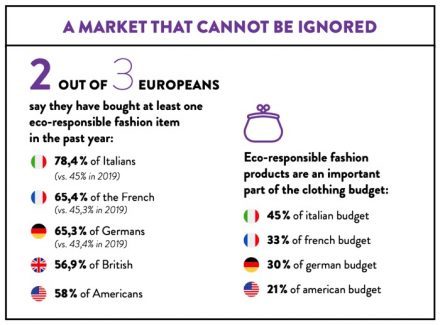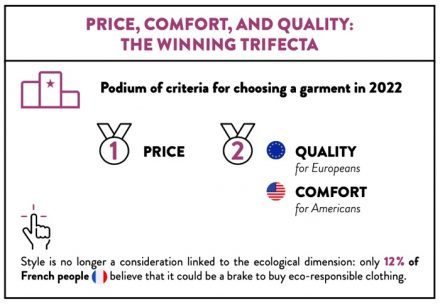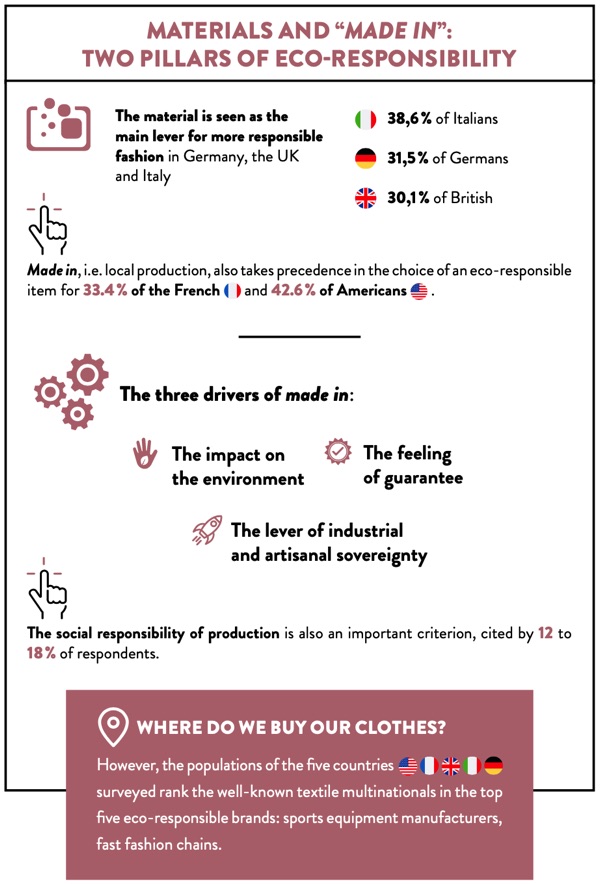Première Vision x IFM Study: Consumers and eco-responsible fashion The - Première Vision Paris - Denim Première Vision - Première Vision New York
Conducted with a sample of 7000 people in 5 countries (France, United Kingdom, Italy, Germany and the United States), this study carried out by Première Vision and the Institut Français de la Mode aims to understand consumption patterns, expectations, and also the level of awareness of consumers regarding eco-responsibility.
Eco-responsible fashion isn’t just a trend
What this study, led by Gildas Minvielle, Director of IFM’s Economic Observatory, illustrates above all the solidity of a market that cannot be ignored.
In fact, it now represents one third of the clothing budget and 90.5 % of respondents intend to change the way they buy clothes in the near future.


Indisputable criteria
The movement has not altered the well-established trifecta of criteria for choosing a garment: price, comfort, and quality. In 2022, price ranks first, just ahead of quality for Europeans, and comfort for Americans.
In the months ahead, it seems evident that the number-one disincentive will be price. «With the return of inflation and increasingly tight household budgets (as fuel and food prices go up), the decision to buy clothes could become more complex,» says Gildas Minvielle. This is true whether or not clothes are eco-responsible.
Material and production at the heart of concerns
In three countries out of five, the materials used are perceived as the main lever for a more responsible fashion industry. Materials thus appear a key consideration for consumers, who note another dimension that has gained momentum in recent months: the place of production («Made in…»). In two of the countries studied here, an eco-responsible piece of clothing is first of all an item that was produced locally, according to 33.4% of French and 42.6% of American respondents.
But which brands do they approve of in terms of respect for the environment?
On this subject, answers across the five countries surveyed are very homogeneous. Well-known textile multinationals – in particular, sports equipment manufacturers and fast fashion chains – ranked among the top 5 eco-responsible brands. Apart from a few domestic brands, the general public spontaneously cites the biggest names.
Without going further into the real or supposed efforts of each of these brands, the impact of their influence is worth noting. «The priority given to sustainable development in their communication over the last few years seems to have been fruitful,» acknowledges the head of the IFM’s Economic Observatory.


Materials matter
Our relationship with various materials is the result of a constant power struggle between knowledge and perception. On one side are synthetic materials: the discourse has been ongoing for a long time and the public is therefore rather well-informed. Among the materials cited as damaging to the environment, polyester, acrylic and polyamide rank first. Other materials, such as cotton, despite the intensive agriculture it implies, continue to convey a strong symbolic charge linked to childhood and softness.
Among the other materials, linen and wool are favored, and are alternately ranked in the top positions in the five countries studied, ahead of silk by a small margin.
Last but not least, there are the new organic, recycled or plant-based materials. The Première Vision x IFM study shows that only connoisseurs and specialists know about them, and that it is particularly urgent to introduce them to the general public, which has been looking forward to such innovation.
For example, only 5.2% of French respondents and 3.7% of Germans know about materials derived from agricultural waste.
Even more striking for such promising materials, biopolymers (textiles synthesized from renewable resources) are known to very few people in the five countries studied.

Eco-responsible fashion therefore has a major information challenge ahead of it. Through this detailed study by the IFM-Première Vision Chair, brands and retailers can see how far they have come and how far they still must go: they need to explain their manufacturing methods, clear up confusion, and show off their exciting work with new materials.
To keep up to date with the latest innovations and challenges of the fashion industry in terms of eco-responsibility, visit the sustainability section in our online magazine and download our 2 FASHION & ECO-RESPONSIBILITY white papers.
Watch the results of the study commented by Gildas Minvielle during a special PV Paris talk ➔
